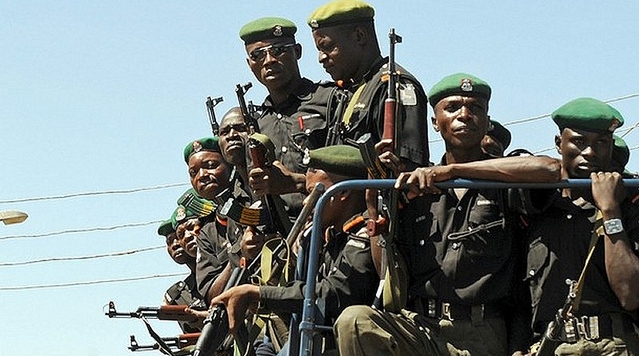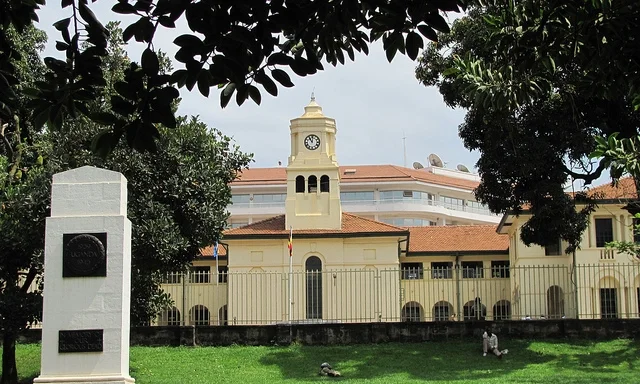WASHINGTON, DC -Julius Winfield Robertson (1916 – 1961) was known as a brilliant litigator, distinguished civil rights activist, author, much sought after speaker, and well-respected member of the legal community in good standing. He was also the lead attorney on the 1955 precedent-setting case Sarah Keys v. Carolina Coach Company.
Born of humble beginnings in rural Georgia, to a family of subsistence farmers, they subsequently moved to Tennessee for better opportunities. In his early 20s, he moved to Washington, DC, to escape the harsh realities of a black man living in the Deep South. While attending Howard University in 1944, Robertson wrote about racism in America in his book titled 'This Bird Must Fly," It formed the basis of his studies and his subsequent pursuit to remedy the inequitable treatment of African-Americans in a system dominated by segregation and Jim Crow Laws.
In 1948, Robertson graduated at the top of his class from Howard University with combined degrees (B.A. and LL.B.), and today because of his academic standing, he would have received the Order of the Coif. The admissions committee at Harvard University Law School, having observed Robertson’s career, offered him a full scholarship to pursue his LL.M., but he was unable to accept the offer because of his young family.
He and classmate James Madison Nabrit, Jr. joined the ranks of renowned civil rights lawyers such as the former U.S. Supreme Court Justice Thurgood Marshall with whom they worked closely in his early years. Robertson, Nabrit, Jr., along with Attorney George E.C. Hayes, were deeply involved in the movement to dismantle segregation through the courts.
Robertson was admitted to the bar in the District of Columbia, District of Columbia Court of Appeals, U.S. District Court of the District of Columbia, U.S. Court of Appeals of the District of Columbia, U.S. Court of Claims, and the United States Supreme Court. He worked as a sole-proprietor until he established the law firm Robertson & Roundtree in 1952 as the senior and managing partner. Robertson hired Attorney Dovey J. Roundtree, upon her graduation from Howard University, and was credited by Roundtree as being her mentor.
He was sponsored to argue cases before the U.S. Supreme Court for the first time in 1952, then in 1954, 1955, 1959, and 1960 shortly before his untimely death. He was a member in good standing of the American Bar Association—one of its first ‘official’ Black members, the National Bar Association, and the District of Columbia Bar Association.
Robertson was recognized as a gifted intellectual with a broad range of knowledge of national and international geopolitics. As a constituent of Senator Estes Kefauver (D-Tenn.), Robertson, had many appointments with him to discuss critical Civil Rights issues. During these meetings, Kefauver discovered that Robertson spoke, wrote, and read fluent German. He then asked if Robertson would be willing to research and gain background information for a bill he was sponsoring.
Robertson reviewed the evidence presented during the Nuremberg War Crimes Tribunal, particularly regarding “Permissible Medical Experiments,” the standards used to judge the German doctors on trial at the time. These became codified as the Nuremberg Code, which was used in part to establish “the requirements that all research participants be fully informed about potential risks or harm that may result from taking part in a study and that, based on this information, they voluntarily agree to participate.”
Using this standard, Sen. Kefauver and Rep. Oren Harris (D-Ark.) sponsored a bill that “established a framework that required drug manufacturers to prove scientifically that a medication was not only safe but effective.” This legislation became known as the Kefauver-Harris Amendment; it was signed into law by President Kennedy on Oct. 10, 1962.
According to written reports and my mother's anecdotal stories, my grandfather was a brilliant litigator, distinguished civil rights activist and author, much sought after speaker, and well-respected member of the legal community in good standing.
It also seems at that time; my grandfather also enjoyed some press for his part in identifying and taking down a con-artist impersonator.
· In 1944 my grandfather, Attorney Robertson, wrote about Race Relations in This Bird Must Fly.
· JET Magazine, December 2, 1954, featured an article about this landmark case titled, ICC To Outlaw Jim Crow In Interstate Travel.
· In 1955 Attorney Robertson argued a Civil Rights cases on behalf of the plaintiff Sarah Keys v. Carolina Coach Company
· JET Magazine, November 23, 1961, pg. 50, Smooth Talker Tangles With.
· JET Magazine, July 13, 1961, pg. 23, His Obituary
Not only did Robertson pursue desegregation in the courts, his then-teenage daughter, Annette M. (Robertson) McGee, was in the 2nd ‘handpicked’ class to integrate the then ‘elite’ all-white college prep Theodore Roosevelt High School in Washington, D.C. Her selection was based upon academic acumen, outstanding grades, being from a professional and well-educated family, and possessing a clear understanding of the importance of their role in the Civil Rights movement in education.
His Civil Rights movement legacy persists through his surviving children Annette M. (Robertson) McGee and her sister, Mrs. Dale (Robertson), and their children, who are lawyers and human rights activists.
CIVIL RIGHTS CASE BACKGROUND: MIDNIGHT IN THE JIM CROW SOUTH
The Keys case originated in an incident that occurred at a bus station in the tiny North Carolina town of Roanoke Rapids shortly after midnight on August 1, 1952, when African-American WAC private Sarah Keys was forced by a local bus driver to yield her seat in the front of the vehicle to a white Marine as she traveled homeward on furlough. At the time of the incident, Jim Crow laws entirely governed Southern bus travel, despite a 1946 Supreme Court ruling meant to put an end to the practice.
That decision, Morgan v. Virginia (328 US 373 (1946)), had declared state Jim Crow laws inoperative on interstate buses on the basis that the imposition of widely varying statutes on black passengers moving across state lines generated multiple seat changes and thus created the kind of disorder and inconsistency forbidden by the commerce clause of the U.S. Constitution.
Southern carriers managed to dodge the Morgan decision, however, bypassing segregation rules of their own, and those rules remained outside the purview of state and federal courts because they pertained to private businesses. Also, the federal agency charged with regulating the carriers, the Interstate Commerce Commission, had historically interpreted the Interstate Commerce Act's discrimination ban as permitting separate accommodations for the races so long as they were equal.
The ICC had ruled so consistently against black complainants since its establishment in 1887 that it had become known as "the Supreme Court of the Confederacy." The ICC's 'separate but equal' policy, upheld by the Supreme Court of the United States in a 1950 railway dining car segregation case known as Henderson v. United States (399 US 816 (1950)), thus remained the norm in public transportation.
So hardened was the practice of Jim Crow in Southern travel when Sarah Keys made her journey in 1952 that even black travelers who had started their journey in the North on integrated trains or buses were, with few exceptions, forced to comply with Jim Crow carrier regulations once they crossed into the South.
When Sarah Keys departed her WAC post in Fort Dix, New Jersey on the evening of July 31, 1952 for her home in the town of Washington, North Carolina, she boarded an integrated bus and transferred without incident in Washington, D.C. to a Carolina Trailways vehicle, taking the fifth seat from the front in the white section.
When the bus pulled into the town of Roanoke Rapids, North Carolina, however, a new driver took the wheel and demanded that she comply with the carrier's Jim Crow regulation by moving to the so-called "colored section" in the back of the bus so that a white Marine could occupy her seat. When Keys refused to move, the driver emptied the bus, directed the other passengers to another vehicle, and barred Keys from boarding it.
An altercation ensued, and Keys was arrested, charged with disorderly conduct, jailed incommunicado overnight, then convicted of the disorderly conduct charge and fined $25.
A THREE-YEAR BATTLE FOR JUSTICE
When that charge was sustained on appeal by a North Carolina lower court, Keys and her father brought the matter to the attention of the National Association for the Advancement of Colored People (NAACP) office in Washington, D.C., headed by Howard University Law School professor Frank D. Reeves.
With Thurgood Marshall, Reeves had run the Legal Defense Fund's New York City office in the early 1940s, and he was working with Marshall and his team in the early 1950s on the legal drive to end school segregation that would culminate in the groundbreaking 1954 Brown v. Board decision.
Reeves referred the Sarah Keys matter to his former law student, Julius W. Robertson, and his junior partner, Dovey Johnson Roundtree, a World War II WAC who had herself been subjected to Jim Crow during her military travels. The match of client and attorneys proved fortuitous.
Sarah Keys v. Carolina Coach Company, 64 MCC 769 (1955) is a landmark civil rights case in the United States in which the segregationist Interstate Commerce Commission, in response to a complaint filed in 1953 by a Women's Army Corps (WAC) private named Sarah Louise Keys, broke with its past racist practice and banned the segregation of black passengers in buses traveling across state lines.
The November 1955 ruling, publicly announced six days before Rosa Parks' historic defiance of state Jim Crow laws on Montgomery buses, applied the United States Supreme Court's logic in Brown v. Board of Education (347 US 483 (1954)) for the the first time to the field of interstate transportation, and closed the legal loophole that private bus companies had long exploited to impose their own Jim Crow regulations on black interstate travelers.
Keys v. Carolina Coach was the only explicit rejection ever made by either a court or a federal administrative body of the Plessy v. Ferguson (163 US 537 (1896)) 'separate but equal' doctrine in the field of bus travel across state lines, and the ruling made legal history both at the time of its issuance and again in 1961, when Attorney General Robert F. Kennedy invoked it in his successful battle to end Jim Crow travel during the Freedom Riders' campaign.
Attorney Robertson argued the case on the eve of the explosion of civil rights protest across America, and Keys v. Carolina Coach Company, along with its companion train desegregation case, NAACP v. St. Louis-San Francisco Railway Company, 298 ICC 335 (1955), represents a crucial milestone in the legal battle for racial justice in the United States.
Source: My mother, Annette M. (Robertson) McGee, and her sister, Mrs. Dale (Robertson) Ore, are the only surviving relatives of Attorney Julius Winfield Robertson and are available to verify and corroborate the information I have presented here.
Editor-in-Chief: @ayannanahmias
LinkedIn: Ayanna Nahmias
































